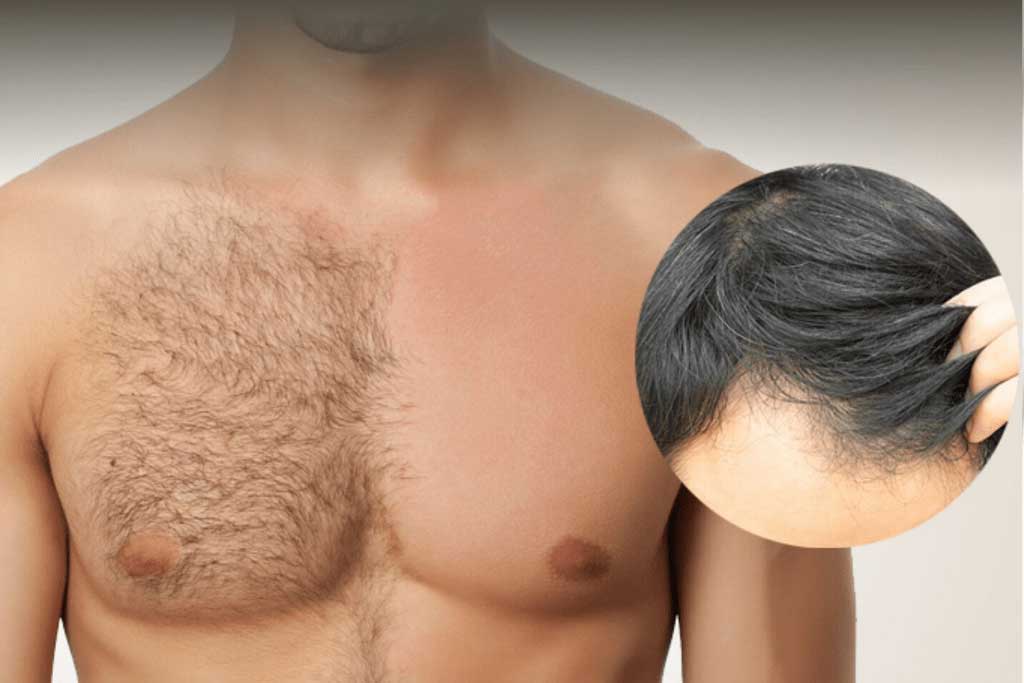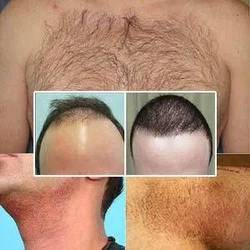Get personalized Consultation!
The Complete Guide to Body Hair Transplantation
Imagine a world where confidence is just a procedure away. At Vida Skin and Hair Transplant Clinic, we bring you the ultimate solution to hair loss – Body Hair Transplantation. In this comprehensive guide, we’ll walk you through the entire process, from understanding the basics to the do’s and don’ts. Let’s embark on this journey to rediscovering your confidence together!
At Vida Skin and Hair Transplant Clinic, we understand the importance of appearance and how it can affect your confidence. That’s why our clinic offers a comprehensive solution for those who are looking to enhance their hairline and overall hair density through body hair transplantation. With our expertise and state-of-the-art techniques, we aim to provide natural-looking results that will leave you feeling satisfied and confident.
Step by Step Insight into Body Hair Transplantation
Body hair transplantation is a surgical procedure that involves transferring healthy hair follicles from one part of the body, known as the donor site, to the balding or thinning areas of the scalp. This procedure is an ideal option for individuals who have insufficient hair on the scalp to achieve the desired density or who have already undergone multiple traditional hair transplants.
The process begins with a thorough consultation with our experienced hair transplant surgeon. During this consultation, the surgeon will evaluate the donor site and discuss your expectations and goals. Once the decision to proceed with body hair transplantation is made, the procedure can be scheduled.
On the day of the procedure, you will be made comfortable, and the donor site will be prepared. Depending on the extent of the hair loss and the desired outcome, the surgeon may choose to extract hair from areas such as the chest, back, arms, or legs. The donor hair follicles will then be carefully extracted using either the follicular unit extraction (FUE) or follicular unit transplantation (FUT) technique.


Types of Grafts Used in Body Hair Transplantation
Follicular Unit Extraction (FUE): The magic happens with FUE – a minimally invasive technique where individual hair follicles are extracted from donor areas and meticulously transplanted to the target site.
Follicular Unit Transplantation (FUT): FUT involves removing a strip of tissue with hair follicles from the donor area and transplanting it to the recipient site. It’s a tried-and-true method that delivers impressive results.
Benefits and Risks of Body Hair Transplantation
Body hair transplantation offers several benefits over traditional hair transplants. It provides a solution for individuals with limited donor hair on their scalp and allows for the achievement of desired hair density. Additionally, since body hair has a similar texture and growth cycle to scalp hair, the results appear natural.
However, as with any surgical procedure, there are risks involved. These include the possibility of infection, scarring, and the potential for hair follicles not growing as expected. It is crucial to have a thorough consultation with your surgeon to discuss the potential risks and ensure that you are a suitable candidate for the procedure.
Preparing for Body Hair Transplantation
To ensure the best possible outcome, it is important to prepare for body hair transplantation. Your surgeon will provide specific instructions tailored to your case, but some general guidelines to follow include:
- Avoiding blood-thinning medications and supplements in the weeks leading up to the procedure.
- Quit smoking, as it can affect the healing process.
- Refrain from drinking alcohol for a period before the surgery.
- Arrange for transportation to and from the clinic on the day of the procedure.
- Follow any additional instructions provided by your surgeon to ensure a successful transplantation experience.
Aftercare and Recovery from Body Hair Transplantation
Following body hair transplantation, it is crucial to follow the aftercare instructions provided by your surgeon. This may include:
- Taking prescribed medications, such as antibiotics or pain relievers.
- Washing your scalp gently and following a specific hair care routine.
- Avoiding strenuous activities or exercise for a specified period.
- Protecting the scalp from direct sunlight or extreme temperatures.
The recovery period varies from person to person, but most individuals can expect to resume normal activities within a few days. It is important to note that the transplanted hair will initially shed before new hair growth occurs. Patience is key during this phase, as it can take several months for the full results to become apparent.
Tips for Successful Body Hair Transplantation
To ensure a successful body hair transplantation experience, consider the following tips:
- Communication: Openly communicate your expectations and concerns with your surgeon during the consultation and follow-up visits.
- Follow Instructions: Adhere to the pre and post-operative instructions provided by your surgeon.
- Patience: Understand that hair growth takes time and be patient throughout the recovery process.
- Maintain a Healthy Lifestyle: Healthy habits such as a balanced diet and regular exercise can aid in the success of the procedure.
- Choose an Experienced Surgeon: Research and select a reputable and experienced surgeon who specializes in body hair transplantation.
Alternatives to Body Hair Transplantation
While body hair transplantation is an effective solution for many, it is important to be aware of alternative options. These may include medical treatments, such as medications or laser therapy, which can help slow down hair loss or stimulate hair growth. Additionally, wearing hairpieces or wigs can provide a temporary solution for those who are not ready for a surgical procedure.
It is recommended to consult with a hair transplant specialist to determine the best approach for your specific case.
Types of Body Hair Transplantation
Body hair transplantation can involve the extraction of hair from various donor areas, including the chest, back, arms, or legs. The choice of the donor area depends on factors such as the texture and quality of the hair, as well as the patient’s preferences and goals.
Why Choose Body Hair Transplantation
Body hair transplantation offers an effective solution for individuals dealing with hair loss who have limited donor hair on their scalp. It provides an opportunity to achieve the desired hair density and restore a natural-looking hairline. With advancements in technology and the expertise of experienced surgeons, body hair transplantation has become a reliable and successful procedure for many.
Do's and Don'ts
To ensure the best possible outcome from your body hair transplantation, here are some essential do’s and don’ts:
Do’s:
- Follow the pre and post-operative instructions provided by your surgeon.
- Be patient and understand that hair growth takes time.
- Maintain a healthy lifestyle to support the success of the procedure.
Don’ts:
- Don’t smoke or drink alcohol before or after the surgery, as it can hinder the healing process.
- Avoid sun exposure or extreme temperatures that may affect the transplanted area.
- Don’t neglect follow-up appointments with your surgeon to monitor progress and address any concerns.
In conclusion, body hair transplantation at Vida Skin and Hair Transplant Clinic is a comprehensive solution for individuals looking to enhance their hairline and achieve optimal hair density. Understanding the procedure, its benefits and risks, and following the necessary aftercare instructions are essential for a successful outcome. With the guidance of experienced surgeons, body hair transplantation can provide natural-looking results that boost confidence and improve overall appearance.
Frequently Asked Questions!
A body hair transplant is a hair restoration technique that involves harvesting hair follicles from areas other than the scalp, such as the chest, back, or beard, and transplanting them to the scalp. This method is particularly useful for individuals with limited donor hair on the scalp, providing an alternative source of hair for transplantation.
Ideal candidates for a body hair transplant are individuals with insufficient donor hair on the scalp for traditional transplantation methods. Those with a good body hair supply and specific aesthetic goals, such as enhancing density or addressing advanced hair loss, may benefit from this technique. Consulting with a qualified hair restoration specialist is essential to determine eligibility.
Common donor sites for body hair transplantation include the chest, back, beard, and other body areas with viable hair follicles. The choice of donor site depends on factors such as hair type, quality, and patient preferences. The healthcare provider will assess and recommend the most suitable donor areas based on individual needs.
While the recovery process shares similarities with traditional hair transplantation, patients undergoing a body hair transplant may experience some differences. Post-operative care instructions, including avoiding strenuous activities and certain grooming practices, are crucial for both methods. However, the specific guidelines may vary, and it’s essential to follow the advice provided by the healthcare professional for optimal results.
When performed by a skilled and experienced hair restoration specialist, the results of a body hair transplant can look remarkably natural. The choice of appropriate donor sites, meticulous transplantation techniques, and artistic considerations contribute to achieving aesthetically pleasing and harmonious results. Patients can expect a gradual and natural-looking transformation as the transplanted hair adapts and grows over time.
While body hair transplant can be a valuable solution, it does come with some limitations. Body hair tends to have a different texture and growth cycle than scalp hair, making it crucial for the surgeon to carefully select and place the follicles to achieve a natural look. Additionally, the yield of viable grafts from body hair may be lower compared to traditional donor areas.
The timeline for noticeable results after a body hair transplant is similar to traditional methods. Initial growth is expected within a few weeks, but significant improvement is typically observed within six to twelve months as the transplanted hair matures and thickens. Patience is key, as the transformation is a gradual process.
Yes, body hair transplantation can be combined with other procedures, such as traditional FUE or FUT, to maximize the overall outcome. This approach allows for a comprehensive and customized treatment plan based on the patient’s unique needs and the extent of hair loss. A thorough consultation with a healthcare provider will determine the most effective combination.
Like any surgical procedure, there are potential risks and complications associated with body hair transplantation. These can include infection, scarring, and suboptimal growth. However, when performed by a qualified professional in a sterile environment, the risks are minimized. Patients should carefully follow post-operative care instructions to reduce the likelihood of complications.
Yes, body hair transplant provides a permanent solution for hair loss. The transplanted hair follicles are resistant to the effects of hormones causing hair loss, making them a long-lasting solution. However, it’s essential to manage expectations, as the natural aging process may still affect non-transplanted hair over time. Regular follow-ups with a healthcare provider can address any evolving concerns.